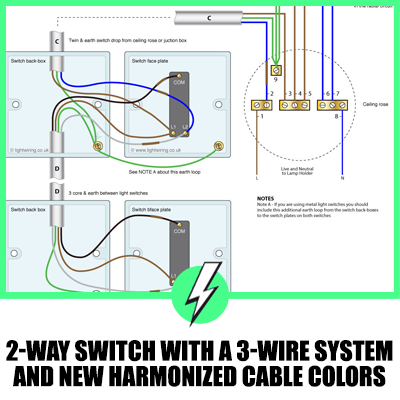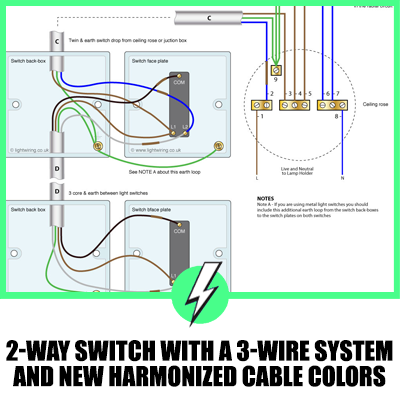Multi-Point Radial Lighting Circuit With New Cable Colours
Are you looking to get a handle on the multi-point radial lighting circuit and the new cable colour standards in the UK?
The multi-point radial lighting circuit, a staple in UK electrical wiring, ensures efficient power distribution to multiple lighting points from a single source.
Recent updates to wiring regulations have introduced new cable colours, marking a significant shift in the industry.
In this article, we’ll break down the essentials of the multi-point radial lighting circuit, delve into the specifics of the new cable colours, and discuss their implications for both professionals and DIY enthusiasts.
Well, we’ll be going over:
- What exactly is a multi-point radial lighting circuit, and how does it function?
- What are the new cable colours, and why were they introduced?
- How do these changes affect the installation and modification of lighting circuits?
Understanding these aspects will not only enhance your knowledge of electrical wiring but also ensure compliance with the latest standards.
Let’s dive in!

Contents
Overview of the Multi-Point Radial Lighting Circuit
The multi-point radial lighting circuit is designed to supply power to various lighting fixtures from a central source.
It consists of a lighting circuit cable that originates from the consumer unit (fuse box) and connects to a series of lighting points, such as ceiling lights or wall-mounted fixtures, throughout a building or room.
The circuit is arranged in a radial manner, meaning that each lighting point branches off directly from the main circuit cable.
For those unfamiliar with lighting circuits, this serves as an excellent introductory point.
Multi-point radial lighting circuit (old cable colours)
We’ll begin by clarifying the workings of the most typical lighting circuit and then proceed to discuss various adaptations you might encounter in your residence, which might seem to deviate from the standard setup.
Please note, the diagrams provided here utilize the traditional cable colors.
If the cables in your circuits are Brown and Blue, refer to the “Multi-point radial lighting circuit – new cable colours” for guidance.
Fig 1 shows what is referred to as a radial circuit (sometimes called a ‘loop-in’ or ‘multi-point radial lighting circuit’).

Fig 1: multi point (loop-in) radial lighting circuit
The light wiring diagram shows how the live feed from the Consumer unit (fuse board, shown in blue in Fig 1) feeds into the first ceiling rose (ceiling rose A, Fig 1).
This would be cable A in the diagram below (Fig 2) which shows how the ceiling rose is terminated.
This live feed now loops back out of the rose (cable B, Fig 2) and feeds power to the next ceiling light in the radial circuit (Ceiling rose B, Fig 1).
This repeats for each light in the circuit until we reach the last light.

Fig 2: Ceiling rose (new harmonised cable colours)
Once we reach the last light, you can see that there is only The feed from ceiling rose B (Fig 1), This is Cable A in the diagram below (Fig 3), which show how the last ceiling rose in the circuit is terminated.
Notice that each of the three ceiling roses in Fig 1 has, in addition to the power feeds, an additional cable that feeds down to the light switches (the switch wire).
This the Cable C in fig 2 & Fig 3.

Fig 3: Radial circuit last ceiling rose in the circuit (new harmonised colours)
Key Components and Connections
- Consumer Unit: The circuit originates from the consumer unit, where the lighting circuit is connected to a dedicated circuit breaker or fuse for protection.
- Circuit Cable: A cable, usually with three cores (live, neutral, and earth), is used to carry the electrical supply from the consumer unit to the lighting points.
- Lighting Points: Each lighting point is connected to the circuit cable using individual cables, enabling power distribution to various fixtures.
- Switches: Switches are installed at each lighting point to control the on/off operation of the connected fixtures.
New Cable Colours
In recent years, the UK has adopted new cable colour standards to enhance safety and conformity in electrical installations.
The previous red (live), black (neutral), and green/yellow (earth) colour scheme has been replaced by a harmonized set of colours:
- Live: Brown
- Neutral: Blue
- Earth: Green and yellow striped
These new cable colours are used in the multi-point radial lighting circuit to ensure consistency and compliance with current wiring regulations.
It is important to adhere to these standards when installing or modifying electrical wiring to maintain safety and facilitate easy identification of wiring components.
Advantages of the Multi-Point Radial Lighting Circuit
- Simplicity and Cost-effectiveness: The multi-point radial lighting circuit is relatively straightforward to install and is cost-effective compared to alternative wiring configurations.
- Flexibility: It allows for the addition or removal of lighting points without affecting the rest of the circuit, offering flexibility in lighting design and future modifications.
- Efficient Power Distribution: The radial layout minimizes voltage drops, ensuring consistent and reliable lighting performance across all connected fixtures.
Conclusion
The multi-point radial lighting circuit with new cable colours is a fundamental wiring configuration used in the UK.
By understanding its key components, connections, and the updated cable colours, individuals can safely and effectively install or modify lighting circuits in accordance with current regulations.
This configuration’s simplicity, flexibility, and efficient power distribution make it a preferred choice for lighting installations in residential and commercial settings alike.




